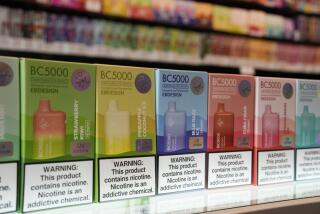U.S. Judge OKs FDA’s Power to Regulate Tobacco
- Share via
WASHINGTON — In a major defeat for the tobacco industry, a federal judge in North Carolina ruled Friday that the Food and Drug Administration has the right to regulate cigarettes and other tobacco products.
U.S. District Judge William L. Osteen Sr. agreed with the FDA that nicotine is a drug and that cigarettes are drug-delivery systems, putting these products squarely under agency jurisdiction.
His ruling, if upheld on appeal, will allow the FDA to enforce regulations designed to bar the sale of cigarettes to people younger than 18.
More generally, it will give the FDA the power to control or eliminate nicotine, the component of tobacco that the agency has declared to be addictive. Theoretically, the FDA could even ban cigarettes, although FDA officials have said repeatedly that they do not intend to do so.
At the same time, Osteen struck down FDA regulations that severely restrict cigarette advertising and promotion to young people. Although the tobacco industry took comfort from this aspect of the decision, analysts said the key part of the ruling went the FDA’s way.
It was a historic decision that effectively endorsed the federal government’s decision to end its traditional hands-off policy toward the powerful tobacco industry.
And it was all the more astonishing because it was issued by a federal district court in tobacco-producing Greensboro, N.C., by a judge who himself once worked as a paid lobbyist for tobacco growers. Industry leaders filed their legal challenge to the FDA there because they believed that it was in tobacco country that they had their best chance of winning.
Although industry officials vowed to keep fighting, their response to the ruling was unusually subdued. In a joint statement, the major cigarette companies said they would contest the facts of the case presented by the government that served as the basis for Osteen’s ruling.
“The court noted that the industry can contest those factual assertions as the case proceeds--and we will,” the companies’ statement said.
Osteen’s decision thus is certain to be only the beginning of a lengthy and acrimonious legal battle. Both sides said they will appeal the portion of the decision they lost, and the case is expected ultimately to reach the Supreme Court.
As Osteen issued his decision, the tobacco companies were continuing recent talks with state attorneys general over a possible settlement of state lawsuits seeking compensation for the massive costs imposed on the states in treating people with smoking-related illnesses. The tobacco companies are seeking protection from further lawsuits as part of any settlement.
Numerous members of the public health community have condemned the idea of granting such legal immunity to the industry, which is facing hundreds of lawsuits and, for the first time in history, appears vulnerable as both public policy and public sentiment have turned against it.
In his 65-page ruling, Osteen wrote: “The court finds that tobacco products fit within [the FDA’s] definitions of ‘drug’ and ‘device.’ ”
He supported the FDA’s contention that nicotine is “intended to affect the structure or function of the body,” part of the legal language that defines the nature of drugs under the agency’s authority. The FDA argued that nicotine, because of its addictive properties, fits this definition even though it does not have known therapeutic benefits as a drug.
*
Osteen rejected the industry’s argument that the FDA’s jurisdiction is confined to drugs and medical devices that provide medicinal benefits. “Nothing in the legislative history indicates that Congress intended to limit the [FDA’s] reach to devices offered for beneficial or therapeutic purposes,” he wrote.
One of the key issues at stake in the legal battle has been the power of the federal government to enact and enforce regulations designed to block teenagers’ access to cigarettes, with the goal of dramatically reducing the number of young people who take up smoking.
President Clinton last summer announced new rules that aimed to do just that. The first phase, forbidding sales to people younger than 18 and requiring proof of age from anyone who looks younger than 27, went into effect in February.
Scheduled to take effect Aug. 28 are regulations banning cigarette vending machines in most locations, prohibiting self-service cigarette displays and free samples, and requiring that cigarette packages bear the statement: “Nicotine-Delivery Device for Persons 18 or Older.”
Although Osteen upheld these rules, he issued an order postponing their implementation until the appeals process is complete.
Clinton called the ruling “a great victory for us . . . especially coming, as it does, out of North Carolina.” The government began its campaign against “overwhelming odds” and “against a powerful interest group,” Clinton added.
Former FDA Commissioner David A. Kessler, who launched the agency’s new aggressive approach toward the tobacco industry more than three years ago, described the ruling as “a victory for the nation, for the president, for the public health, but, most importantly, for our children.”
Kessler added: “It will change the way tobacco products are viewed in this country forever.”
For its part, the tobacco industry reiterated its desire that Congress resolve the issues.
“As we have long stated, the public policy issues at stake in this case can be addressed most effectively through the legislative process of our government,” it said. “By seeking a legislative solution, the issues presented in this case will receive a fair and thorough review in a forum that is the most appropriate for their consideration.”
Both the joint statement and a separate one by the Brown & Williamson Tobacco Corp., whose brands of cigarettes include Kool and Lucky Strike, focused on the aspect of Osteen’s ruling upholding the industry’s position on its right to advertise.
Brown & Williamson said it was “very pleased with the decision today by the court in North Carolina. . . . We won today on the major commercial issue, which was our right to freely advertise and promote our product to adult consumers.”
The FDA had sought to severely curtail advertising and promotion geared toward young people. For instance, the government sought to ban cigarette logos on T-shirts, baseball caps and other products; eliminate billboards within 1,000 feet of schools and playgrounds, and reduce most ads to black-and-white text only, the so-called tombstone format.
But Osteen struck down the advertising rules, saying the statute cited by the FDA did not apply in this case. He did not, however, rule that the advertising restrictions were a 1st Amendment violation of free-speech guarantees, as the industry had hoped.
The FDA has authority under another statute--its drug provisions--to regulate the advertising and promotion of drugs, and is expected to use this avenue if the other approach fails on appeal.
“We need to study the opinion before we decide on other regulatory approaches, but we do have the authority under other statutes,” said an administration official familiar with drug laws, who requested anonymity.
*
The U.S. 4th Circuit Court of Appeals--which will hear the appeals to Osteen’s ruling--sits in Richmond, Va., and has a history of supporting such advertising restrictions. It upheld Baltimore’s attempt to pass an ordinance banning alcohol and tobacco billboards within city limits--a far more restrictive regulation than that proposed by the FDA.
Also, when the Supreme Court overturned a Rhode Island ordinance banning alcohol advertising on billboards and ordered the 4th Circuit to reconsider its Baltimore decision, the court stood by its original ruling.
Despite the efforts by the tobacco industry to put the best possible face on Osteen’s decision, public health advocates saw it as decidedly one-sided.
“If Big Tobacco cannot win on FDA jurisdiction in its own backyard, it is unlikely to win anywhere,” said William D. Novelli, president of the Campaign for Tobacco-Free Kids.
Sen. Edward M. Kennedy (D-Mass.) agreed, saying: “The tobacco industry picked the legal forum where it thought it had the best chance to succeed--and still lost. Tens of thousands of lives may well be saved because of this decision.”
* INDEPENDENT JUDGE
Osteen is described as a man of impeccable integrity. D1
(BEGIN TEXT OF INFOBOX / INFOGRAPHIC)
Ruling’s Impact
If Friday’s ruling were to withstand appeal, the Food and Drug Administration:
* would have the authority to regulate cigarettes as drug delivery services.
* would not be able to regulate content or placement of cigarette advertisement
* would be able to ban cigarette vending machines except in establishments where children are not permitted.
The percentage of high school seniors who smoked cigarettes daily in the past 30 days:
22.2% smoked daily in 1996
Source: The University of Michigan Monitoring the Future Study; compiled by ROB CIOE / LOS ANGELES TIMES
More to Read
Sign up for Essential California
The most important California stories and recommendations in your inbox every morning.
You may occasionally receive promotional content from the Los Angeles Times.













